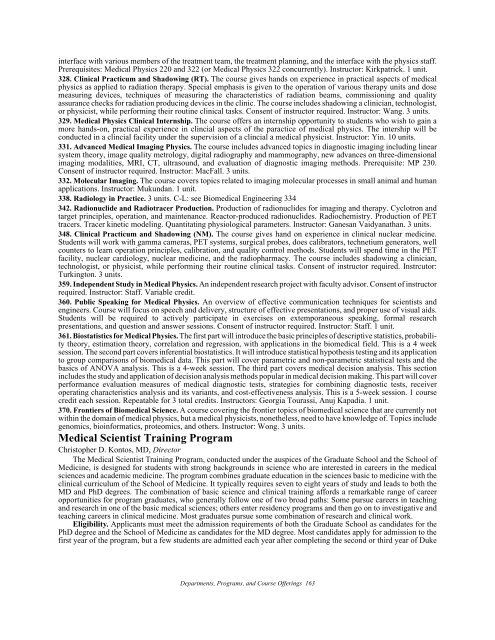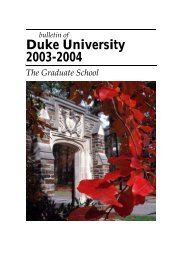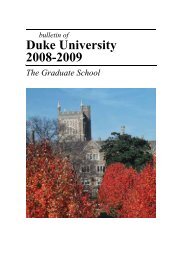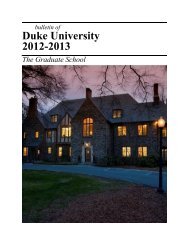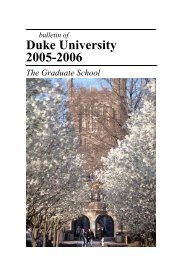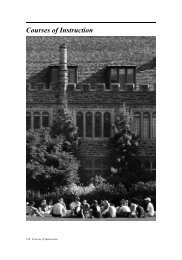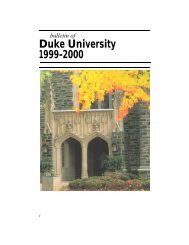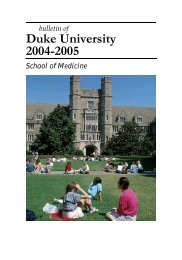Duke University 2009-2010 - Office of the Registrar - Duke University
Duke University 2009-2010 - Office of the Registrar - Duke University
Duke University 2009-2010 - Office of the Registrar - Duke University
Create successful ePaper yourself
Turn your PDF publications into a flip-book with our unique Google optimized e-Paper software.
interface with various members <strong>of</strong> <strong>the</strong> treatment team, <strong>the</strong> treatment planning, and <strong>the</strong> interface with <strong>the</strong> physics staff.<br />
Prerequisites: Medical Physics 220 and 322 (or Medical Physics 322 concurrently). Instructor: Kirkpatrick. 1 unit.<br />
328. Clinical Practicum and Shadowing (RT). The course gives hands on experience in practical aspects <strong>of</strong> medical<br />
physics as applied to radiation <strong>the</strong>rapy. Special emphasis is given to <strong>the</strong> operation <strong>of</strong> various <strong>the</strong>rapy units and dose<br />
measuring devices, techniques <strong>of</strong> measuring <strong>the</strong> characteristics <strong>of</strong> radiation beams, commissioning and quality<br />
assurance checks for radiation producing devices in <strong>the</strong> clinic. The course includes shadowing a clinician, technologist,<br />
or physicist, while performing <strong>the</strong>ir routine clinical tasks. Consent <strong>of</strong> instructor required. Instructor: Wang. 3 units.<br />
329. Medical Physics Clinical Internship. The course <strong>of</strong>fers an internship opportunity to students who wish to gain a<br />
more hands-on, practical experience in clincial aspects <strong>of</strong> <strong>the</strong> paractice <strong>of</strong> medical physics. The intership will be<br />
conducted in a clincial facility under <strong>the</strong> supervision <strong>of</strong> a clincial a medical physicist. Instructor: Yin. 10 units.<br />
331. Advanced Medical Imaging Physics. The course includes advanced topics in diagnostic imaging including linear<br />
system <strong>the</strong>ory, image quality metrology, digital radiography and mammography, new advances on three-dimensional<br />
imaging modalities, MRI, CT, ultrasound, and evaluation <strong>of</strong> diagnostic imaging methods. Prerequisite: MP 230.<br />
Consent <strong>of</strong> instructor required. Instructor: MacFall. 3 units.<br />
332. Molecular Imaging. The course covers topics related to imaging molecular processes in small animal and human<br />
applications. Instructor: Mukundan. 1 unit.<br />
338. Radiology in Practice. 3 units. C-L: see Biomedical Engineering 334<br />
342. Radionuclide and Radiotracer Production. Production <strong>of</strong> radionuclides for imaging and <strong>the</strong>rapy. Cyclotron and<br />
target principles, operation, and maintenance. Reactor-produced radionuclides. Radiochemistry. Production <strong>of</strong> PET<br />
tracers. Tracer kinetic modeling. Quantitating physiological parameters. Instructor: Ganesan Vaidyanathan. 3 units.<br />
348. Clinical Practicum and Shadowing (NM). The course gives hand on experience in clinical nuclear medicine.<br />
Students will work with gamma cameras, PET systems, surgical probes, does calibrators, technetium generators, well<br />
counters to learn operation principles, calibration, and quality control methods. Students will spend time in <strong>the</strong> PET<br />
facility, nuclear cardiology, nuclear medicine, and <strong>the</strong> radiopharmacy. The course includes shadowing a clinician,<br />
technologist, or physicist, while performing <strong>the</strong>ir routine clinical tasks. Consent <strong>of</strong> instructor required. Instrcutor:<br />
Turkington. 3 units.<br />
359. Independent Study in Medical Physics. An independent research project with faculty advisor. Consent <strong>of</strong> instructor<br />
required. Instructor: Staff. Variable credit.<br />
360. Public Speaking for Medical Physics. An overview <strong>of</strong> effective communication techniques for scientists and<br />
engineers. Course will focus on speech and delivery, structure <strong>of</strong> effective presentations, and proper use <strong>of</strong> visual aids.<br />
Students will be required to actively participate in exercises on extemporaneous speaking, formal research<br />
presentations, and question and answer sessions. Consent <strong>of</strong> instructor required. Instructor: Staff. 1 unit.<br />
361. Biostatistics for Medical Physics. The first part will introduce <strong>the</strong> basic principles <strong>of</strong> descriptive statistics, probability<br />
<strong>the</strong>ory, estimation <strong>the</strong>ory, correlation and regression, with applications in <strong>the</strong> biomedical field. This is a 4 week<br />
session. The second part covers inferential biostatistics. It will introduce statistical hypo<strong>the</strong>sis testing and its application<br />
to group comparisons <strong>of</strong> biomedical data. This part will cover parametric and non-parametric statistical tests and <strong>the</strong><br />
basics <strong>of</strong> ANOVA analysis. This is a 4-week session. The third part covers medical decision analysis. This section<br />
includes <strong>the</strong> study and application <strong>of</strong> decision analysis methods popular in medical decision making. This part will cover<br />
performance evaluation measures <strong>of</strong> medical diagnostic tests, strategies for combining diagnostic tests, receiver<br />
operating characteristics analysis and its variants, and cost-effectiveness analysis. This is a 5-week session. 1 course<br />
credit each session. Repeatable for 3 total credits. Instructors: Georgia Tourassi, Anuj Kapadia. 1 unit.<br />
370. Frontiers <strong>of</strong> Biomedical Science. A course covering <strong>the</strong> frontier topics <strong>of</strong> biomedical science that are currently not<br />
within <strong>the</strong> domain <strong>of</strong> medical physics, but a medical physicists, none<strong>the</strong>less, need to have knowledge <strong>of</strong>. Topics include<br />
genomics, bioinformatics, proteomics, and o<strong>the</strong>rs. Instructor: Wong. 3 units.<br />
Medical Scientist Training Program<br />
Christopher D. Kontos, MD, Director<br />
The Medical Scientist Training Program, conducted under <strong>the</strong> auspices <strong>of</strong> <strong>the</strong> Graduate School and <strong>the</strong> School <strong>of</strong><br />
Medicine, is designed for students with strong backgrounds in science who are interested in careers in <strong>the</strong> medical<br />
sciences and academic medicine. The program combines graduate education in <strong>the</strong> sciences basic to medicine with <strong>the</strong><br />
clinical curriculum <strong>of</strong> <strong>the</strong> School <strong>of</strong> Medicine. It typically requires seven to eight years <strong>of</strong> study and leads to both <strong>the</strong><br />
MD and PhD degrees. The combination <strong>of</strong> basic science and clinical training affords a remarkable range <strong>of</strong> career<br />
opportunities for program graduates, who generally follow one <strong>of</strong> two broad paths: Some pursue careers in teaching<br />
and research in one <strong>of</strong> <strong>the</strong> basic medical sciences; o<strong>the</strong>rs enter residency programs and <strong>the</strong>n go on to investigative and<br />
teaching careers in clinical medicine. Most graduates pursue some combination <strong>of</strong> research and clinical work.<br />
Eligibility. Applicants must meet <strong>the</strong> admission requirements <strong>of</strong> both <strong>the</strong> Graduate School as candidates for <strong>the</strong><br />
PhD degree and <strong>the</strong> School <strong>of</strong> Medicine as candidates for <strong>the</strong> MD degree. Most candidates apply for admission to <strong>the</strong><br />
first year <strong>of</strong> <strong>the</strong> program, but a few students are admitted each year after completing <strong>the</strong> second or third year <strong>of</strong> <strong>Duke</strong><br />
Departments, Programs, and Course Offerings 163


